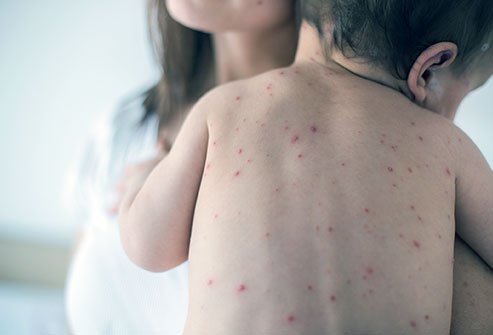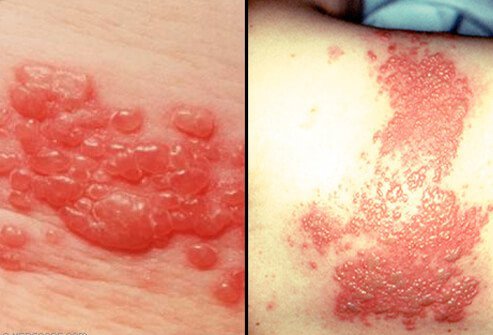What's the Difference Between Chickenpox and Shingles?
What are chickenpox and shingles?

Chickenpox and shingles are two infectious diseases that are often confused with one another. That’s because they’re caused by the same virus, called varicella-zoster.
Varicella is a highly contagious virus that spreads through coughing and sneezing, or through direct contact with an infected skin lesion. It commonly spreads in schools, due to the high volume of students potentially in close contact. Adults can get infected with varicella, too, and these cases tend to be more serious than in those of healthy children.
Vaccinating against chickenpox is very common in the U.S. There’s also a vaccine available for shingles for people who are 50 and older.
What is chickenpox?
The first time you get infected with the varicella virus, you get chickenpox. This disease starts as a fever or general feeling of being unwell. Then you develop sores on your body. These sores start out as raised red bumps on the skin and progress to blisters. They can be mildly uncomfortable or incredibly itchy. You can also get complications from chickenpox like swelling of the brain and infection of the lungs (pneumonia).
What is shingles?
Shingles is a condition you can develop if you’ve already had chickenpox. After you recover from chickenpox, the virus stays dormant inside you. The virus can then reappear years or decades later as shingles. Shingles is most common in older adults. In fact, 1 in 3 adults living in the United States develop shingles. Children can also develop shingles, but it’s quite rare.
You don’t have to be advanced in age to get shingles. It can also affect people with weakened immune systems. This disease is known for its distinctive blister rash that can develop on the torso or the face. It can also cause extreme nerve pain that can last for weeks and even months after the rash is gone.
Shingles cannot be spread from person to person. Someone with shingles can spread the varicella virus to another person, but that person would get chickenpox.
Symptoms of chickenpox and shingles
Although both diseases are caused by the same virus, you can tell them apart relatively easily.
Symptoms of chickenpox
Chickenpox is preventable with a vaccine. About 98% of people who have been immunized don’t develop it. The 2% who will contract chickenpox usually experience mild cases. The illness lasts for one week on average.
Signs and symptoms of chickenpox include:
- Sudden onset of fever
- Loss of appetite
- Body aches and chills
- Red, itchy rash on the body (may develop on eyes, inside the mouth, and genital area)
- Fluid-filled blisters that break and scab
You start to feel the symptoms of chickenpox 10 to 21 days after exposure. This can make it hard to pinpoint exactly when you or your child might have contracted it.
Although this disease normally affects children, adults can get it too. Adults usually get more severe cases than children do. People who are pregnant or have weakened immune systems are more likely to develop side effects.
There can be serious side effects of chickenpox. They include:
- Dehydration
- Bacterial infection of cuts and breaks in the skin lesions
- Pneumonia
- Inflammation or infection of the brain
- Possible fetal defects in pregnant women
- Death
Symptoms of shingles
Shingles — also known as herpes zoster — has distinctive symptoms, such as nerve pain. This pain can last for weeks or even months after the other symptoms have cleared (post-herpetic neuralgia).
Symptoms of shingles include:
- Headache
- Fever
- Muscle aches and chills
- Tingling or itchy skin
- Painful, blister-like rash on the torso, face, eyes, or genitals
- Rash typically appears on one side of the body
Recovery time varies. On average, the rash clears within 7 to 10 days and nerve pain lessens or disappears within 2 to 4 weeks.
The risk for complications increases with the age of the patient. Long-term nerve pain is the most common complication of shingles. It can last for months or even years after the rash has disappeared. It’s described as a burning, shooting, stabbing pain.
Other complications of shingles are:
- Full or partial blindness (if shingles spread to the eyes)
- Pneumonia
- Loss of hearing
- Brain inflammation
- Death

IMAGES
See Images
Causes of chickenpox and shingles
Both diseases are originally spread from person to person. The key difference is that shingles happen when the varicella virus reactivates years after recovery from chickenpox.
Causes of chickenpox
Chickenpox is caused by the virus varicella-zoster. You can become infected through contact with someone who has chickenpox or shingles. It spreads through droplets, like when coughing or sneezing. It can also spread if you touch a ‘pock,’ or skin lesion.
When you get chickenpox, you’re contagious from 1 to 2 days before the rash develops until after all the blisters have scabbed.
Causes of shingles
You cannot get shingles from someone who has shingles. If you’ve never been vaccinated for chickenpox, then it’s possible to get chickenpox from someone with shingles.
Unlike chickenpox, you can’t spread the virus through droplets. You can only spread shingles through direct contact with the blisters or rash. It’s unlikely you’ll spread the virus if you keep the rash covered. After the blisters develop a crust, you’re no longer contagious.
Stages of chickenpox and shingles
The progress of each disease can be marked through stages. Some stages will last longer for some, depending on your age, immune system, and other factors.
Stages of chickenpox
The main stages in chickenpox are:
- Exposure to the virus: It takes 10 to 21 days after exposure for symptoms to start.
- Initial symptoms: Feeling unwell, body aches, fever, and headache are usually the first symptoms to set in.
- Small red bumps on the body: These usually develop on the torso or face first, eventually covering the body.
- Bumps develop into blisters: The itchy lesions will fill with fluid and become blisters.
- Blisters scab over and heal: After all your blisters scab over, you’re no longer contagious.
Stages of shingles
- Feeling unwell: You might develop fever, headaches, or body aches before developing the rash.
- Tingling pain: It’s common to feel tingles, pain, or itchiness in the area the rash will develop.
- Burning rash: Anywhere from 1 to 5 days after the tingling started, the rash will start to develop.
- Blisters: The rash will start to blister and then crust over.
You may still feel mild or extreme pain after the rash is gone, due to a condition called post-herpetic neuralgia (PHN). You can develop shingles more than once, but it is rare.
Diagnosing chickenpox and shingles
The doctor will usually be able to diagnose chickenpox or shingles by inspecting the rash and marks, noting your signs and symptoms, and asking you about your vaccination history. They can also do several tests to confirm that you have the varicella virus, such as:
- Blood test: A needle is inserted into a vein and a vial of blood is removed. The blood is then tested for the varicella virus or its antibodies.
- Blister test: A fluid sample is taken from a blister with a cotton swab. It’s then tested for varicella or antibody properties.
If you think you or your child could have chickenpox, contact your doctor. Since chickenpox is highly contagious, the doctor’s office may have procedures that safeguard against infection. It’s best to call first and inform them about your reason for visiting.
Treatments for chickenpox and shingles
There are vaccines available for both shingles and chickenpox. Today, they’re widely used in the U.S. and around the world.
Shingrix is a vaccination for shingles that’s recommended for healthy adults over the age of 50. Varicella is the vaccine used for chickenpox. It’s usually administered to children between the ages of 12 and 15 months, and then again between 4 and 6 years old.
A cool bath infused with baking soda, oatmeal, or colloidal oatmeal may help soothe the skin lesions caused by chickenpox and shingles. Applying calamine lotion can also help calm the skin and reduce itchiness.
Resist scratching your skin while you have chickenpox or shingles, because it can leave the wounds open to infection and cause scars on your skin.
Aspirin is not recommended for pain relief when you have chickenpox. Its use has been associated with Reye’s syndrome in children who have chickenpox. Reye’s syndrome is a serious disease that affects the brain and liver.
If you have shingles, your doctor may prescribe an antiviral medicine to ease symptoms and speed healing. These medicines are most effective when taken as soon as the rash develops:
- Famciclovir
- Acyclovir
- Valacyclovir
Consult your doctor before taking medication.
